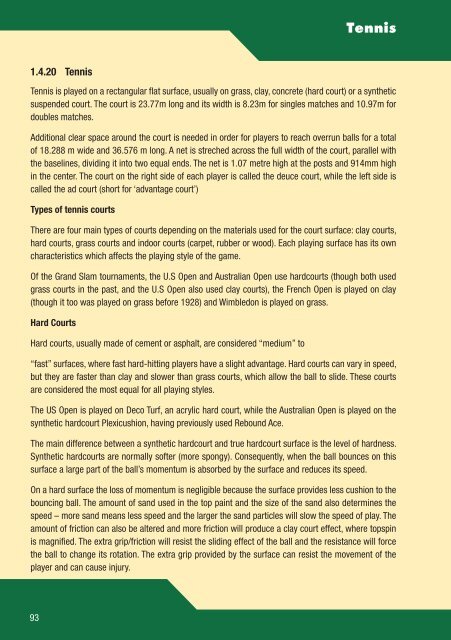SASR Norms & Standards Vol 2 new.indd - Sport and Recreation ...
SASR Norms & Standards Vol 2 new.indd - Sport and Recreation ...
SASR Norms & Standards Vol 2 new.indd - Sport and Recreation ...
Create successful ePaper yourself
Turn your PDF publications into a flip-book with our unique Google optimized e-Paper software.
1.4.20 Tennis<br />
Tennis is played on a rectangular fl at surface, usually on grass, clay, concrete (hard court) or a synthetic<br />
suspended court. The court is 23.77m long <strong>and</strong> its width is 8.23m for singles matches <strong>and</strong> 10.97m for<br />
doubles matches.<br />
Additional clear space around the court is needed in order for players to reach overrun balls for a total<br />
of 18.288 m wide <strong>and</strong> 36.576 m long. A net is streched across the full width of the court, parallel with<br />
the baselines, dividing it into two equal ends. The net is 1.07 metre high at the posts <strong>and</strong> 914mm high<br />
in the center. The court on the right side of each player is called the deuce court, while the left side is<br />
called the ad court (short for ‘advantage court’)<br />
Types of tennis courts<br />
There are four main types of courts depending on the materials used for the court surface: clay courts,<br />
hard courts, grass courts <strong>and</strong> indoor courts (carpet, rubber or wood). Each playing surface has its own<br />
characteristics which affects the playing style of the game.<br />
Of the Gr<strong>and</strong> Slam tournaments, the U.S Open <strong>and</strong> Australian Open use hardcourts (though both used<br />
grass courts in the past, <strong>and</strong> the U.S Open also used clay courts), the French Open is played on clay<br />
(though it too was played on grass before 1928) <strong>and</strong> Wimbledon is played on grass.<br />
Hard Courts<br />
Hard courts, usually made of cement or asphalt, are considered “medium” to<br />
“fast” surfaces, where fast hard-hitting players have a slight advantage. Hard courts can vary in speed,<br />
but they are faster than clay <strong>and</strong> slower than grass courts, which allow the ball to slide. These courts<br />
are considered the most equal for all playing styles.<br />
The US Open is played on Deco Turf, an acrylic hard court, while the Australian Open is played on the<br />
synthetic hardcourt Plexicushion, having previously used Rebound Ace.<br />
The main difference between a synthetic hardcourt <strong>and</strong> true hardcourt surface is the level of hardness.<br />
Synthetic hardcourts are normally softer (more spongy). Consequently, when the ball bounces on this<br />
surface a large part of the ball’s momentum is absorbed by the surface <strong>and</strong> reduces its speed.<br />
On a hard surface the loss of momentum is negligible because the surface provides less cushion to the<br />
bouncing ball. The amount of s<strong>and</strong> used in the top paint <strong>and</strong> the size of the s<strong>and</strong> also determines the<br />
speed – more s<strong>and</strong> means less speed <strong>and</strong> the larger the s<strong>and</strong> particles will slow the speed of play. The<br />
amount of friction can also be altered <strong>and</strong> more friction will produce a clay court effect, where topspin<br />
is magnifi ed. The extra grip/friction will resist the sliding effect of the ball <strong>and</strong> the resistance will force<br />
the ball to change its rotation. The extra grip provided by the surface can resist the movement of the<br />
player <strong>and</strong> can cause injury.<br />
93<br />
Tennis



